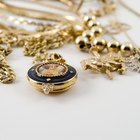Part of working through your divorce agreement is splitting up the physical items you've collected over the years. Agreeing on dividing household items in divorce saves you lots of money compared to letting your attorneys decide who should get what. Judges usually don't want to mess with dividing belongings during the proceedings. As you're deciding who gets each item, you might want to know the worth of different items. If there are disputes over certain items, the court might require the value of the items in question to help decide how to split them. There are several ways to come up with values on items depending on what they are and how well you're getting along with your soon-to-be ex-spouse.
Make a List
An important first step is writing a comprehensive list of the items you own together. In general, anything either spouse owned before the marriage is considered personal property and belongs to that spouse. Gifts are also generally considered personal property. Anything you acquired during the marriage is community property and subject to splitting.
Go through each room while creating your list to ensure you record everything. Some small things like food, toilet paper and cleaning supplies don't need to go on the list. Once your list is complete, identify items that fall under the personal property of either of the spouses. Those items don't need a value assigned to them since they automatically go to that spouse. Make sure both people have a copy of the list.
Strategies for Estimating Value
Many regular household items are low in value and aren't of concern to the court. If you're trying to decide how to fairly split the items, you might come up with an estimate of the value yourselves. Keep in mind that most items lose significant value after purchasing, even if they're only a few months old. The purchase price can be a starting point, but depreciation means it's not still worth that much. One option is to estimate how much you could sell an item for. However you account for depreciation, make sure you use a consistent method with all items.
If you can agree on estimated values, you can use those numbers to figure out how you're going to divide the items. If you can't agree on the values, you can each write down what you think something is worth. Then, average the two values to get an estimated value for the item.
Appraisals for High-Value Items
Appraisals are an option for higher-ticket household items like valuable artwork or antiques. Keep in mind that an appraisal adds to your cost, so it's best only for high-value items. One way to decide what should be appraised is to set a minimum value. Anything that is likely worth more than that amount gets appraised. You can also think about your insurance policy. The items that are individually insured on your homeowner's policy are probably worthy of an appraisal. You also need to decide who will pay for the appraisal fee.
Let a Third Party Decide
Can't decide how to split the items, or feel like your spouse is being greedy? A neutral third party like an arbitrator or mediator can help you figure out how to divide things. These options are generally much cheaper than letting your lawyers hash out the property division.
Related Articles

Household Inventory Checklist for a ...

How to Get Personal Belongings Back ...
How Old Do You Need to Be to Rent a Car?

How to Cater Your Own Party

How to Decide What Is a Fair Price to ...

How to Buy Food for Inmates

Typical Markup of Retail Fashion
What Is Consignment?

How to Sort Through Your Parent's ...

How to Ask for Money on Wedding ...

How to Number a Jewelry Inventory
How to Save Money at Disney World

The Negative Effects of Expensive ...

Divorce Assistance for Women

Wedding Gift Etiquette When Invited to ...

What Is the Proper Gift for People ...

Traditional Indian Wedding Gifts

How to Organize a Church Bazaar

How to Create a Wedding Registry at ...

List of Wedding Items Needed
References
Writer Bio
Shelley Frost writes professionally on a full-time basis, specializing in lifestyle, family, parenting and relationship topics. She holds an education degree and has extensive experience working with kids and parents.